Figure 8-5.—Formats of ship and station newspapers.
program and have a good graphics file and a large
selection of type fonts from which to choose.
NEWSPAPER FORMATS
LEARNING OBJECTIVE: Recognize the types
of formats of ship or station newspapers.
The three formats used in ship and station
newspapers are full format, tabloid and magazine. These
formats are shown in figure 8-5 and are described in the
following text.
FULL FORMAT
A full-format (also known as broadsheet)
newspaper is one that measures 16 or 17 inches wide
and 21 to 22 inches deep. A fill-format newspaper can
be made to have five columns, six columns, seven and
one-half columns, eight columns or nine columns.
TABLOID
A tabloid newspaper is about half the size of a
full-format newspaper. It measures 10 to 12 inches wide
and 14 to 18 inches deep. A tabloid format newspaper
can have two, three, four, five, five and one-half and six
columns.
MAGAZINE
A magazine-format (also known as compact)
newspaper is about half the size of a tabloid newspaper.
It measures 7 to 8 inches wide and 10 to 11 inches deep.
It can be made to have one column, two columns and
three columns.
NEWSPAPER DESIGN
LEARNING OBJECTIVE: Detail the
techniques used in ship or station newspaper
design and any specific considerations,
respectively.
Other important considerations (beyond the news
gathering, news writing and copy editing aspects
covered in the preceding chapters) are the techniques for
putting the material together so that your paper
emphasizes what is important. You will also need to
know what makes an attractive appearance and draws
and holds the reader’s eye. All of this is done through
good layout and makeup designed to achieve the best
overall appearance and style of the publication and to
allow the reader to obtain the maximum information in
the shortest time.
Layout is the planning of the position and page that
each piece of copy or art will occupy in your publication.
This includes your choosing the styles and sizes of
headlines desired, the kinds and sizes of type to be used
and deciding how to use them, and indicating these plans
on the layout sheets.
Makeup is normally the execution of that layout by
the publisher (the compositor), although sometimes the
terms layout and makeup are used interchangeably. For
instance, the name “makeup editor” is used on some
newspapers instead of “layout editor.”
THE DUMMY
Indicating on the layout sheet where each element
will be placed (sometimes called dummying or roughing
in) may be done as each segment of material is
forwarded to the publisher. Some publishers will even
give you rough proofs of galley type, headlines and art
and let you make a paste-up dummy on a layout sheet.
Paste-up dummies ensure a high degree of accuracy in
page makeup because they give the publisher a better
8 -6

